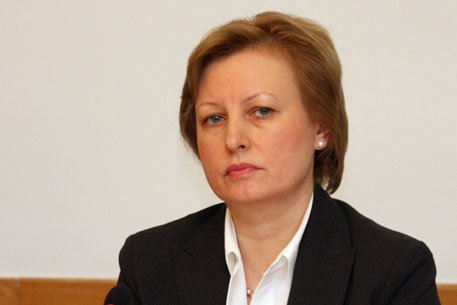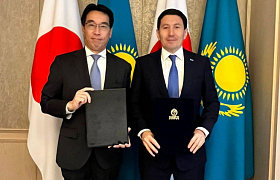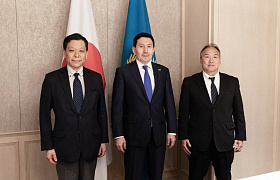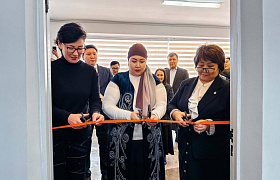“We do not have assets in need of rehabilitation – this is the main difference from the 90’s”

1132
04 February 2015
In 2014 “Samruk-Kazyna” JSC has started privatization program, according to which subsidiaries and dependent companies will be transferred to competitive environment. In total 64 assets were scheduled for sale last year. «Kursiv» has talked to Deputy Chairperson of the Management board of the Fund Ms. Elena Bakhmutova about whether the goals were achieved, as well as principles of privatization program implementation.
- According to the Comprehensive privatization plan 64 companies were scheduled for sale in 2014. How many were actually sold, according to the latest data? What was the final amount of proceeds?
- Last year 12 companies were sold with total price of 4,12 billion Tenge, which is 1,6 times more than appraised value of these assets. The decision on starting price is made by the commission for sale of the assets based on independent appraisal. After that the bidding is done according to the due procedures.
Furthermore, there are other companies, for which now the purchase and sale agreement is now in the process of conclusion. These are the companies, which have been sold to the other partners. According to the documents of incorporation other partners – the co-founders of LLPs have priority purchase right of the share. These rights were exercised in 12 companies. It is expected that the total revenue on these 12 assets will be 20,29 billion Tenge. As for other assets, repeat procedures are done for some of them. Sometimes bidding is done for the third time. Sale of these assets will continue.
- Can the sales be considered a success?
- in terms of the sum, or from the standpoint of return of the value, monetization, it can be called a success. The sellers received monetary funds in exchange for an asset, and naturally, these funds will be now used for other purposes, for implementing investment projects.
- Why, in your opinion, there was demand for these specific companies?
- It is probably interest of the market. It depends on the region, location of a company. Regional aspect is indeed very important, and I think the state register platform has a reputation because it allows attracting interested buyers, it also provides a mechanism, which allows sufficient time – if the first attempt of sale was unsuccessful, it can be done for a second or third time. In anticipation of your next question, if a company is not sold after all possibilities have been exhausted, sectoral commissions have to decide, what is the future for this asset. Maybe some improvements are needed, problems should be solved before putting up the company or share of it for sale.
- Are there such candidates?
- We are not there yet. Well, as an example: for «Kaz-geomash» the bidding failed three times. However, there was a proposal of the second partner to buy out the share, which on first glance was not that interesting, because it required payment by installments, but considering that there was no buyer on the market it is reasonable to reconsider negotiations with this partner to find a compromise.
- Bidding on some of the «NC «KazMunaiGas» JSC failed. What does the Fund plan to do with them in the future? Will there be a re-bidding?
- All mechanisms will be used, and once it becomes clear that there are no buyers, we will need to go back to the asset to understand, what is wrong with it. Maybe the timing was wrong. We have tried to pay attention to disclosing information about a company, including access to the appraisal reports on the company, which contain enough information to understand, what kind of company this is, what are the development perspectives. We understand that these are not hotcakes; to buy a company one needs to understand, what it does, what could be future business. We tried striking reasonable balance between commercial interests of a company, so that we don’t simply disclose information to potential competitors, who do not plan to buy the company, and , finding information necessary for a decision-making, for those, who want to buy this company.
- Who pays for the appraisal?
- According to our policy and regulations, which are published on the “Samruk-Kazyna” website, there is a procedure: each owner prior to selling his share, in part or in full, has to order an independent appraisal by professional appraisers. Independent appraisal is the basis for approving the starting price of sale.
- Yet still do you have to sell redundant assets or those attractive for the market?
- We had a program related to non-core assets. This program continues in its turn. In this case, these are fully non-core assets, some of which should be transferred to the executive bodies. For instance, social facilities. They were a burden for our companies, because they needed maintenance. The question is not in receiving revenues from them, but eliminating non-core assets. This is related only to non-core assets.
In terms of privatization program, which includes sale of 106 assets, of them 64 last year, here preferences of “Samruk-Kazyna” JSC group of companies were taken into account, as well as the probability was assessed of transferring those companies, which can exist in market environment, in such environment. First of all, those companies were sold, which did not present strategic significance or implied sale of share and attraction of a strategic investor.
In some cases, it is sufficient to sell only 49%, in others 51 % have to be sold to a strategic investor, because his preferences should also be taken into account. That is why our companies could be classified into two big categories: the first category are the companies, which do not present strategic significance for the group and can continue existing in competitive environment. As a rule, these companies are sold in full. The second category includes those companies that are of strategic value for “Samruk-Kazyna” JSC or are closely connected with the future activity of the company, In such case it is reasonable to keep a significant share of ownership in such company. Some shares/stocks are put for privatization and strategic investor is attracted. It is expected that strategic investor will ensure co-financing of investment projects, or he will participate in company’s development in other way.
- Are there any failing assets?
- We do not have assets in need of rehabilitation. This is exactly the difference of the current stage of privatization from the one in the 90’s. Back at that time, the companies were sold for the purpose of simply breathing some life into them, because there were hardly viable. In terms of our assets, then almost all assets, if they are operational, can continue operating, but growth points have to be found. In terms of companies out of operation, these could be assets in form of facilities, buildings, equipment. In any case, we are not talking about companies in need of rehabilitation. However, because “Samruk-Kazyna” companies did not find these assets to be strategically important, a new owner has to find an effective way for their development.
- How can you track, whether a new owner preserves the core-activity of an asset? Do the new owners have to preserve the core activity? If a new owner will raise the efficiency of the company, will the obligations on staff stay in place?
- This is all set in the requirements, including the procedure for sale of the company. If it is a simple electronic auction, then the seller in interested only in price. If some restrictions have to be set – this is electronic bidding. Usually, there are two basic restrictions – preserving the number of jobs and collective agreement conditions for a year. Why are we doing this? Because, as a rule, these companies are located in various regions, often in small towns, and people and execution of some contracts depend on operation of these companies. That is why one year is an optimal timeframe, in which people, employed in such company can decide on their future; and the owner familiar with the situation will have a choice to change or preserve activities of the company, if he deems it effective enough. Such conditions should be reflected in the purchase and sale agreement, the control mechanisms for fulfilling the contractual obligations are embedded there as well.
In case of two-stage bidding, usually, stricter requirements are applied to a new owner, even some guarantees etc. The mechanism is the same – the covenants and further actions in case of violation depending on the severity thereof, are included in the purchase and sale agreement. Usually, these are fines, but there could be also a contract termination requirement.
- It was planned before to hold the bidding on the Kazakhstani stock-exchange, but in 2014 decision was made in favor of state register of the Ministry of finance as an optimal option. Why is that?
- I do not exclude the possibility that the bidding can be done through stock exchange, but the question is what is the purpose. In this case, the state register provides a platform for sale. The stock exchange is more a platform for a secondary market, rather than initial sale. We had IPO of KEGOC – over 42 thousand natural persons have bought the stocks. For some reason, there are concerns now in the society about prices volatility. Within the framework of IPO, we mentioned numerous times that we encourage long-term investors, who will own shares for three to five years, who will receive dividends etc. After a month since IPO, 10% of the shares sold during IPO have been already sold on the secondary market. The company has raised money for investing, the tariff policy changed positively. KEGOC is planning to pay out dividends, both for the previous year and the first half of 2015. Going back to the possibility of implementing privatization though stock exchange. If we were planning to actively trade stocks afterwards, this would be reasonable. On the other hand, if we are just trying to sell the company and the new owner does not wish to actively trade on the stock-exchange, if there is no demand on the market, then there is no need to use this rather complex mechanism.
- The names of natural persons or legal entities, who bought shares of the assets, are not published on the website of state register. Is that a secret information? Why is this information not published? Doesn’t it contradict the transparency criteria, it also heats up the talks about privatization is a means to sell assets to “inside people” cheaply.
- This was a collective decision. In any case, in order to publish information about a buyer he has to consent disclosure of information. So far, nobody gave such consent voluntarily. Our main goal was to avoid abusive practices; that is why the sale is done through the mechanisms we have discussed: the bidding is done using electronic platform of state register, company information is disclosed in full, and the buyer has an opportunity to make a voluntary informed decision on purchase. Moreover, the sum of the transaction is published, so any person can always check that all stages of sale were observed. Thus, transparency mechanism is ensured, opportunity for abuse and sale to a pre-established entity is minimized.
- Have you done Dutch auctions over this period?
- So far no, but there is a possibility of moving from English to Dutch auctions.
- Down to what level?
- Such decisions are to be made by commissions. If the commission will think that further decrease of price is incompatible with the main aims and leads to asset impairment, meaning the losses are recorded, than it is reasonable to stop and wait in order to put the asset up for sale in some time.
Рекомендуем

{{ $t('messages.news1') }}
During the official visit of the Head of State to Japan, the Head of S...

{{ $t('messages.news1') }}
Samruk-Kazyna’s CEO Met with the Management of MUFG Bank

{{ $t('messages.news1') }}
Chairman of the Management Board of Samruk-Kazyna JSC Met with the Man...

{{ $t('messages.news1') }}
Inclusion Support Classrooms to Open in 5 Schools of Kulsary


